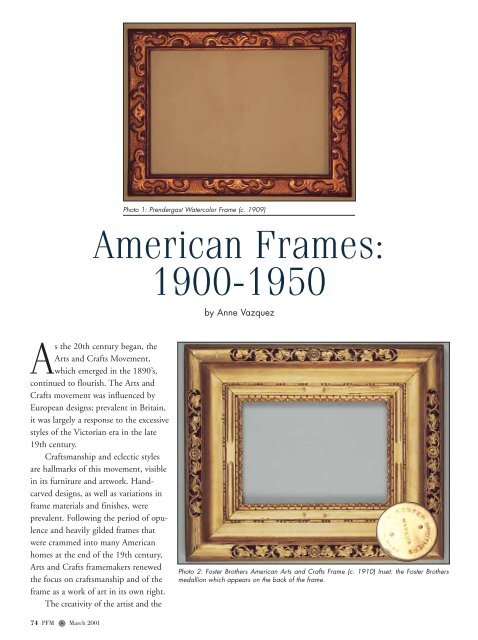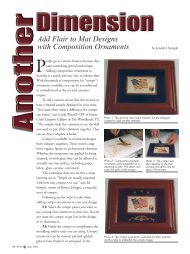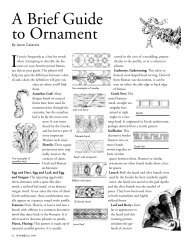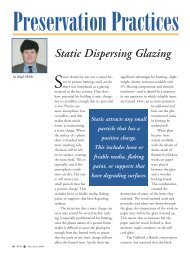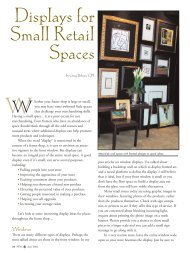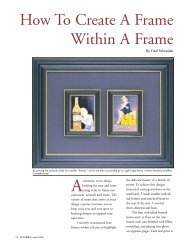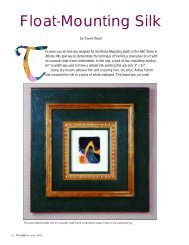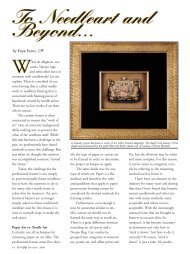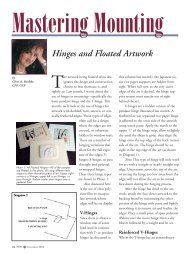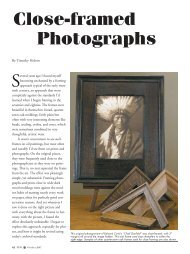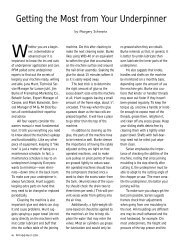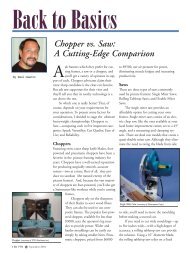American Frames: 1900-1950 - Picture Framing Magazine
American Frames: 1900-1950 - Picture Framing Magazine
American Frames: 1900-1950 - Picture Framing Magazine
Create successful ePaper yourself
Turn your PDF publications into a flip-book with our unique Google optimized e-Paper software.
As the 20th century began, the<br />
Arts and Crafts Movement,<br />
which emerged in the 1890’s,<br />
continued to flourish. The Arts and<br />
Crafts movement was influenced by<br />
European designs; prevalent in Britain,<br />
it was largely a response to the excessive<br />
styles of the Victorian era in the late<br />
19th century.<br />
Craftsmanship and eclectic styles<br />
are hallmarks of this movement, visible<br />
in its furniture and artwork. Handcarved<br />
designs, as well as variations in<br />
frame materials and finishes, were<br />
prevalent. Following the period of opulence<br />
and heavily gilded frames that<br />
were crammed into many <strong>American</strong><br />
homes at the end of the 19th century,<br />
Arts and Crafts framemakers renewed<br />
the focus on craftsmanship and of the<br />
frame as a work of art in its own right.<br />
The creativity of the artist and the<br />
74 PFM _ March 2001<br />
Photo 1: Prendergast Watercolor Frame (c. 1909)<br />
<strong>American</strong> <strong>Frames</strong>:<br />
<strong>1900</strong>-<strong>1950</strong><br />
by Anne Vazquez<br />
Photo 2: Foster Brothers <strong>American</strong> Arts and Crafts Frame (c. 1910) Inset: the Foster Brothers<br />
medallion which appears on the back of the frame.
framemaker (who were often one<br />
and the same), directed the frame<br />
designs, rather than strictly traditional<br />
styles. In fact, a principle of<br />
the Arts and Crafts movement was<br />
to see the framemaker as an artist.<br />
As a result, the relationship between<br />
artists and the craftsman who built<br />
the frames for their art was particularly<br />
close in this period.<br />
The designs of Stanford White,<br />
which gained popularity at the end<br />
of the 19th century, continued to<br />
be appreciated for their classical<br />
motifs. His frames combined opulence<br />
with refinement in designs<br />
heavily based on Italian frames<br />
from the 15th century, and reflected<br />
his appreciation of styles from<br />
the Renaissance. His tabernacle<br />
frames, often made for artist Abbott<br />
Thayer’s paintings, are among his<br />
most well-known designs.<br />
The Prendergast brothers,<br />
Charles and Maurice, were also<br />
prominent in the <strong>American</strong> frame<br />
industry at the turn of the 20th<br />
century. While both men were<br />
artists, Charles’ strength was in<br />
framemaking, while Maurice<br />
excelled as an artist.<br />
Beginning around 1895,<br />
Charles made many frames for his<br />
brother’s artwork. In 1903,<br />
framemaker Hermann Dudley<br />
Murphy began the Carrig-Rohane<br />
firm in his studio in Winchester,<br />
Massachusetts. Charles Prendergast<br />
was his associate in the business.<br />
They moved the firm to Boston in<br />
1905 where their work helped to<br />
establish the city as a central loca-<br />
Photo 4: Arts and Crafts painting frame by Frederick Harer (c. 1915). Inset: Harer’s signed initials,<br />
FH, on the back of the frame.<br />
76 PFM _ March 2001<br />
Photo 3: An <strong>American</strong> Arts and Crafts frame made by Hermann Dudley Murphy/Carrig-Rohane<br />
framemakers. Inset: The hand-carved signature on the back of the frame.<br />
tion in the framemaking trade.<br />
The cassetta frame in Photo 3<br />
was made by Carrig-Rohane. It is<br />
made of wood, hand-carved, and<br />
gilded. Pastiglia was used to create<br />
the decorative pattern the panels.<br />
<strong>Frames</strong> made at Carrig-Rohane<br />
were given a hand-carved signature<br />
on the back (See inset of Photo 3).<br />
Charles Prendergast continued<br />
to gain popularity even after ending<br />
his partnership with Murphy<br />
and leaving Carrig-Rohane. In<br />
1914, he moved to New York City<br />
(another center of framemaking),<br />
funded by an order to make frames<br />
for portraits of past presidents of<br />
an insurance company.<br />
In the meantime, The Newcomb-Macklin<br />
Company, located<br />
in both New York and Chicago,<br />
also produced frames which were<br />
highly regarded. In addition to<br />
working with the Arts and Crafts<br />
designers, the company, which<br />
bought the rights to reproduce<br />
Stanford White’s designs after his<br />
assassination in 1906, worked with
Photo 5: Childe Hassam Frame<br />
(c. 1910-20)<br />
some artists in Taos, New Mexico.<br />
The influence of these relationships<br />
can be seen in many frames<br />
made by The Newcomb-Macklin<br />
Company up until the 1920’s.<br />
The Taos style incorporates<br />
hand-carved Native <strong>American</strong> and<br />
southwestern designs onto the<br />
frame. These frames were most<br />
often gilded. Eanger Irving Couse,<br />
an artist who founded the Taos<br />
School in New Mexico, often specified<br />
“Roman Gilding,” to be used<br />
on his frames. This technique used<br />
highly refined bronze powder<br />
78 PFM _ March 2001<br />
instead of bright gold, resulting in<br />
a low luster finish.<br />
In the West, San Francisco was<br />
another center of framemaking at<br />
the time. As both artists and<br />
framemakers, Arthur and Lucia<br />
Matthews produced hand-carved,<br />
polychromed and gilded frames to<br />
house their paintings. In the spirit<br />
of California, the Matthews often<br />
used motifs were flowers and fruits.<br />
Back East, Frederick Harer was<br />
also a prominent framemaker during<br />
the first quarter of the century.<br />
Located in New Hope, Pennsylvania,<br />
Harer was skilled in woodworking<br />
and used various techniques to<br />
decorate his frames, including stencilling,<br />
incising, matte and burnished<br />
gilding, and punchwork.<br />
The Harer frame in Photo 4 is<br />
a hand-carved wood frame that is<br />
gilded in silver (c. 1915). Prior to<br />
the Arts and Crafts period, silver<br />
was used for reasons of economy.<br />
<strong>Frames</strong> were often gilded in silver<br />
and then covered with shellac to<br />
create a gold tone for a gilded<br />
appearance. However, during the<br />
Arts and Crafts period, the turn<br />
Photo 6: A reproduction of Murphy Style<br />
Design<br />
Photo 7: A reproduction of an <strong>American</strong><br />
Impressionist Design
Photo 8: Modernist Frame (c. 1930’s-40’s)<br />
toward experimenting with materials<br />
and methods resulted in many<br />
framemakers using silver as the final<br />
finish of their frames.<br />
Another development was the<br />
use of red clay (bole) under the silver<br />
gilding. (Traditionally, blue or gray<br />
bole was most often used.) As a result<br />
of using the red bole, the tone of the<br />
frame was different than silver frames<br />
of the past, and this became another<br />
“<strong>American</strong>” technique.<br />
The Foster Brothers firm, established<br />
in 1875 by brothers John Roy<br />
and Stephen Bartlett, was a prominent<br />
framemaker in Boston during<br />
the first few decades of the 20th century.<br />
Known for their exemplary<br />
hand carving, many Foster Brothers<br />
frames were reminiscent of Dutch<br />
frames from previous centuries. They<br />
often featured rippled mouldings and<br />
Photo 9: Frame with cast ornament and painted<br />
(c. 1940-50)<br />
80 PFM _ March 2001<br />
special corner designs, which were<br />
then gilded with gold leaf.<br />
However, their style was not<br />
bound to those components, as can<br />
be seen in the Foster Brothers frame<br />
in Photo 2. While the elaborate hand<br />
carving and gilding has been used,<br />
there is an absence of corner design.<br />
After World War I, industry in<br />
America began to come into its own.<br />
Framemakers and artists alike began<br />
to draw on themes from industry,<br />
and while wood was the primary<br />
frame material, coatings other than<br />
gold came into favor<br />
in the 1920’s. These included silver<br />
(already being used steadily), chrome,<br />
and aluminum, as well<br />
as paint.<br />
Inevitably, the Art Deco period in<br />
the 1920’s influenced frame designs as<br />
well. While the style did not grow to<br />
dominate the craft, geometric shapes<br />
and elements reminiscent of Egyptian<br />
artifacts appeared on many panels at<br />
this time.<br />
During the 1930’s and 1940’s,<br />
marked changes in the economic,<br />
political, and social arenas also had<br />
some effect on the frames of the<br />
time—similar to the effect of World<br />
War I during the 1920’s. Styles were<br />
varied and what some call “freeform.”<br />
In contrast to traditional designs,<br />
there was a Modernist trend toward<br />
the various abstract styles, including<br />
Dadaism, Cubism, and Surrealism<br />
(see Photo 8). As the first half of the<br />
century came to a close, the mood in<br />
post-war America was shifting again,<br />
which would lead frame designs down<br />
yet another path—part of which took<br />
a turn towards minimalism. ■<br />
Photo credits—<br />
Photos 1, 2, 3, 4, and 8:<br />
Gill & Lagodich Fine Period <strong>Frames</strong><br />
Photo 10: Shaped wood frame with silver<br />
gilding (c. 1940)<br />
Photos 5, 9, and 10:<br />
Eli Wilner & Co.<br />
Photo 6 and 7:<br />
The Thanhardt Burger Corporation


